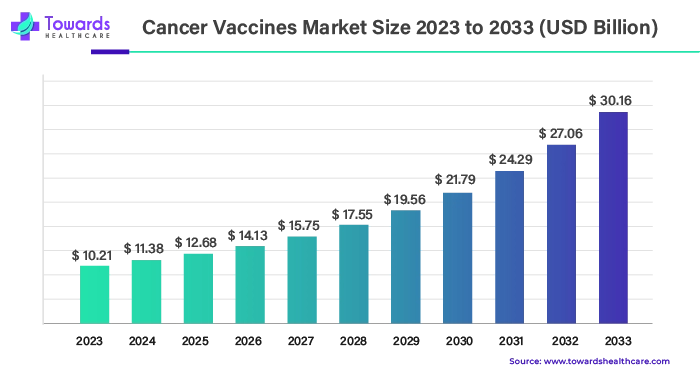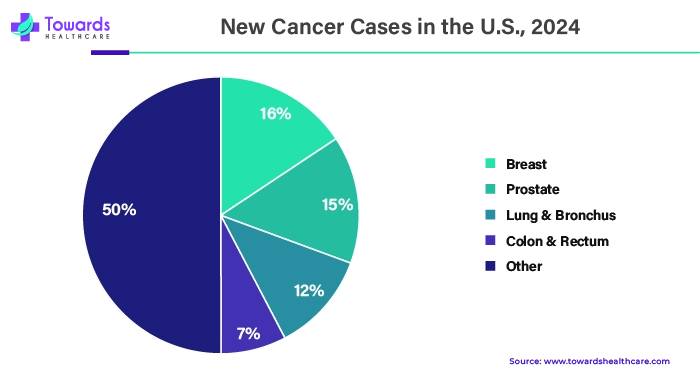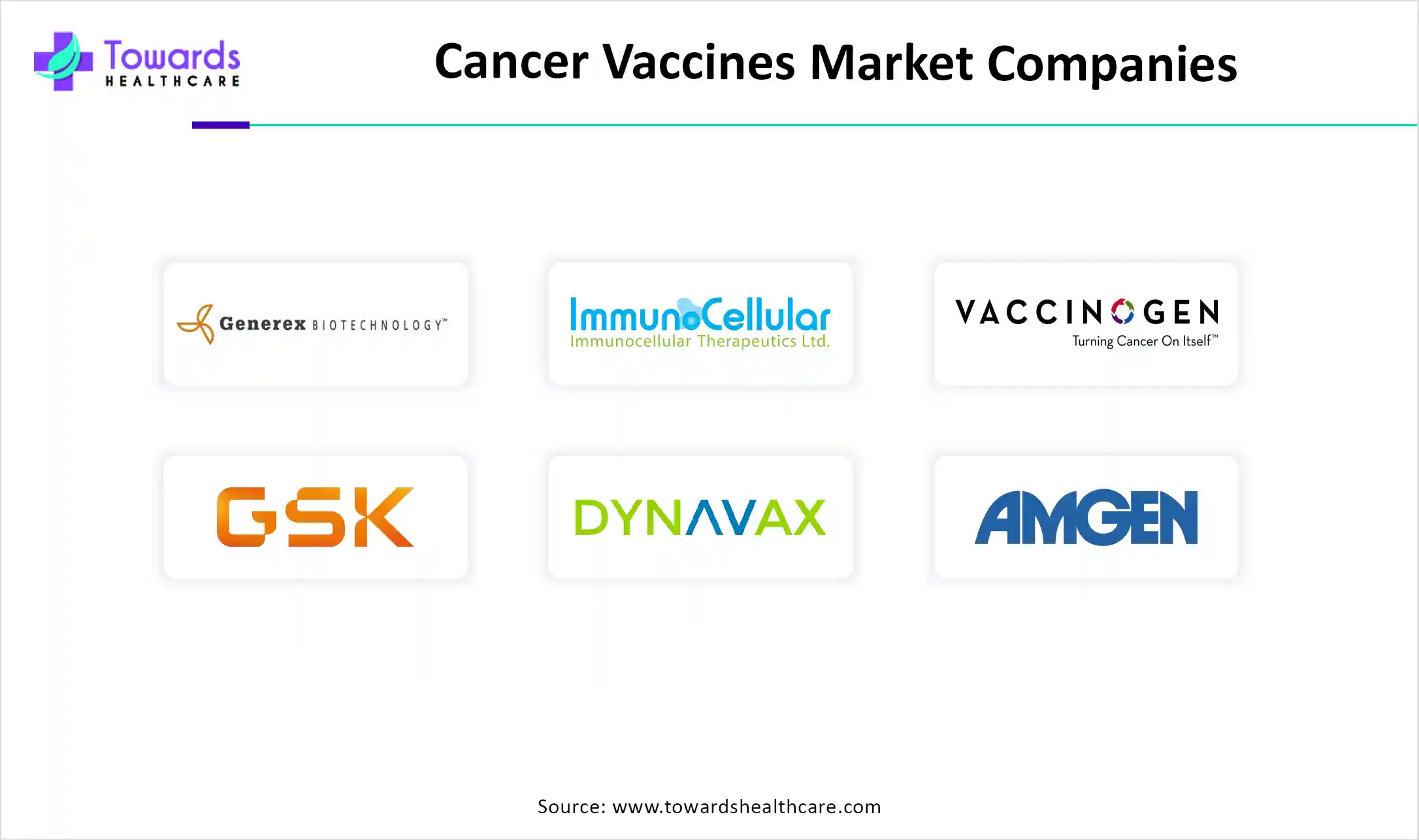April 2025

The cancer vaccines market size is anticipated to grow from USD 11.38 billion in 2025 to USD 33.61 billion by 2034, with a compound annual growth rate (CAGR) of 11.44% during the forecast period from 2025 to 2034.

The cancer vaccines market deals with research & development, testing, manufacturing and distribution of cancer vaccines in the healthcare sector. Cancer vaccines are none other than immunotherapies used as a treatment procedure to boost the immune system of cancer patients for fighting against cancer. There are two types of cancer vaccines: therapeutic and preventive. Currently, HPV vaccines and hepatitis B vaccines are two preventive vaccines approved, while prostate cancer vaccines, bladder cancer vaccines, and melanoma vaccines are some of the therapeutic vaccines that are approved by the Food and Drug Administration.
One of the major reasons for the growth of the market is the increased number of cancer patients due to different factors like lifestyle choices, environmental pollution, genetics, aging, substance abuse, chemical exposure, exposure to sun/UV radiation, and so on. Apart from this, major key players and researchers are continuously making efforts to improve the existing vaccines and develop new vaccines for preventive majors in which the governments are equally participating by providing funds, facilities, and proper infrastructure.
In recent years, the number of cancer patients has grown tremendously. Not only the number but also the types of cancers have increased. Certain factors like genetics, exposure to UV radiation, and occupational hazards have been the major contributors to an increased number of cancer patients. However, factors such as increased rates of obesity, processed food consumption, pollution, unhealthy lifestyles, substance abuse, and lack of knowledge & awareness are all contributing to the increased number of cancer patients.

Tumor heterogeneity is a crucial factor that can negatively impact the growth of the cancer vaccines market. Tumor heterogeneity says that the same or different tumors can show different variations in terms of morphology and genetics in the case of different patients. Due to this, it becomes difficult to produce antigens for vaccines, as one antigen may work differently in different patients. This reduces the efficiency of the vaccines, and more sophisticated tools will be needed to meet the individual needs of patients. It can also lead to treatment failure and reoccurrence of cancer.
A complete treatment strategy that includes radiation, chemotherapy and surgery is beginning to take into account personalized cancer vaccinations. These vaccinations are also being explored in conjunction with other immunotherapy techniques, such as checkpoint inhibitors, in an effort to maximize the immune response's overall efficacy. The results for individuals with different forms of cancer may be improved by more effective treatment procedures that result from this integrated approach.
For instance,
The development of cancer vaccines is heavily reliant on machine learning and artificial intelligence (AI). With the aid of these technologies, it is possible to forecast which tumor antigens would most likely trigger a successful immune response and evaluate enormous volumes of genetic data. In order to guarantee that every patient receives the most effective vaccination based on their particular tumor profile, AI algorithms may also aid in enhancing vaccine design and tailoring treatment strategies. Significant progress in genome sequencing technology is necessary for the creation of cancer vaccines. Researchers can detect precise alterations in a tumor's DNA that can be targeted by vaccination with speed and accuracy thanks to high-throughput sequencing. This has the dual benefits of improving vaccine accuracy and hastening the vaccine development process. A wider range of tailored cancer vaccine applications is made possible by the increasing speed, affordability, and accessibility of genome sequencing.
Based on type insights, the preventive segment dominated the cancer vaccines market in 2023. The majority of vaccines are developed to prevent disease occurrence. It is done by developing inactivated vaccines, live-attenuated vaccines, mRNA vaccines, viral vector vaccines, and so on. Preventive vaccines are highly recommended as they are useful in boosting the immune system even before the development of actual disease. Providing preventive vaccines can reduce the number of cancer cases. It not only improves overall health outcomes but plays a crucial role in reducing the financial burden of the healthcare industry. The use of preventive vaccines can be increased by creative awareness among individuals via campaigns and government initiatives, especially in underdeveloped countries and rural areas.
For instance,
On the other hand, the therapeutics segment is expected to grow with the fastest CAGR during the forecast period. Therapeutic vaccines are given after the occurrence of cancer, and they are given for treatment rather than prevention. The major cause of the increasing demand for therapeutic vaccines is the increasing number of cancer patients. Various factors contribute to the growing number. The geriatric population is also a major contributor to the increased number of cancer patients, as the risk of developing cancer is high in old age. Another factor for growth is the development of personalized vaccines, which can be developed based on the genetic material and other lifestyle factors of individuals. Developing such personalized vaccines provides better results by increasing immune response.
| Cancer Type | Vaccine | Manufactured By (Companies) |
| Preventive Cancer Vaccines | ||
| HPV Related Cancers | Cervarix® | GlaxoSmithKline |
| HPV Related Cancers | Gardasil® | Merck & Co. Inc. |
| HPV Related Cancers | Gardasil-9® | Merck & Co. Inc. |
| HBV-related Liver Cancer | HEPLISAV-B® | Dynavax |
| Therapeutic Cancer Vaccines | ||
| Early-stage Bladder Cancer | Bacillus Calmette-Guérin (BCG) | Merck & Co. Inc. |
| Prostate Cancer | Sipuleucel-T (Provenge®) | Dendreon Pharmaceuticals, LLC |
Based on indication type, the cervical cancer segment dominated the cancer vaccines market in 2023. Cervical cancer is among the top causes of death. The cases of cervical cancer are majorly seen in low and middle-income countries. These countries have people who lack awareness about cervical cancer vaccines, and many people do not have access to vaccines, screening and treatment procedures due to economic and social determinants of health.
The hospitals segment dominated the cancer vaccines market in 2023 and will continue to dominate during the forecast period. Hospitals are the most common place where vaccines are provided and diagnosis of cancer is conducted. People visit hospitals to gain knowledge, prevention, screening, treatment and further monitoring of cancer. Hospitals have a lot of facilities, which can help in conducting multiple treatments under the guidance of specialized healthcare professionals. Better safety, sanitation, expertise and minimum risk are involved in hospital-based vaccination and treatment.

North America dominated the cancer vaccines market in 2023. It is an advanced region when it comes to research and development and technological advancements. These two factors, along with government support, play a crucial role in the dominance. Apart from this, the U.S. and Canada are major contributors to the growth. The U.S. is not only known for clinical research and better technology, but it also has the highest number of cancer patients. According to the National Cancer Institute, nearly 50% of all deaths are due to cancer. The institute also predicted that around 2.0 million new cases of cancer will be observed in the U.S. The U.S. government is also focused on developing new vaccines and funding research projects.
For instance,

Asia Pacific is expected to grow at the fastest rate during the forecast period. According to the estimation of the WHO, Asia is the largest continent with the highest number of cancer patients, and by 2045, the number of cancer patients is estimated to grow by 64.5%. Countries like China, India, Japan, and South Korea majorly contribute to the growth of the cancer vaccines market in the Asia Pacific region. Continuously, new clinical trials are launched to develop and trial new vaccines.
In India, one of the most common causes of death among women is cervical cancer, and the Government of India has taken various initiatives to tackle this issue. The Union Budget 2024–25 encourages frontline healthcare workers to receive insurance and promotes cervical cancer vaccination. February 1, 2024, saw the release of the interim Union Budget 2024–2025, which included a sum of Rs 87,656.90 crore for the Department of Health and Family Welfare.

| Company | GlaxoSmithKline plc (GSK) |
| Headquarters | London, UK, Europe |
| Pipeline | 2023 was a great year for the company, and it is planning to do 12 major launches from 2025, which will include vaccines and specialty medicines related to oncology, HIV, infectious diseases, and respiratory diseases. |
| Company | Merck & Co. Inc. |
| Headquarters | New Jersy, United States, North America |
| Pipeline | Merck and Moderna were working on (MSD)mRNA-4157 vaccine for patients with resected high-risk (Stage IIB-IV) melanoma. After the Approval of the FDA in February 2023, the company entered clinical trial phase III of the vaccine, which included 1089 patients, and the study will be concluded by 2029. |
By Type
By Indication
By Technology
By Distribution Channel
By Geography
April 2025
April 2025
April 2025
April 2025